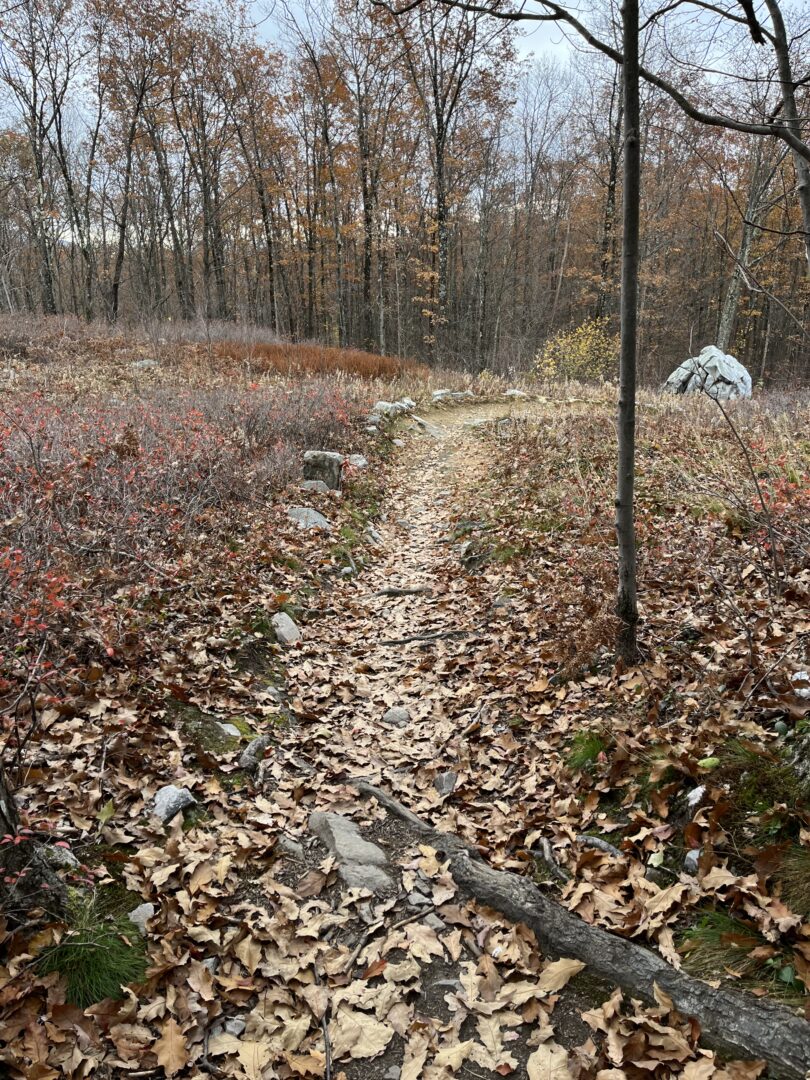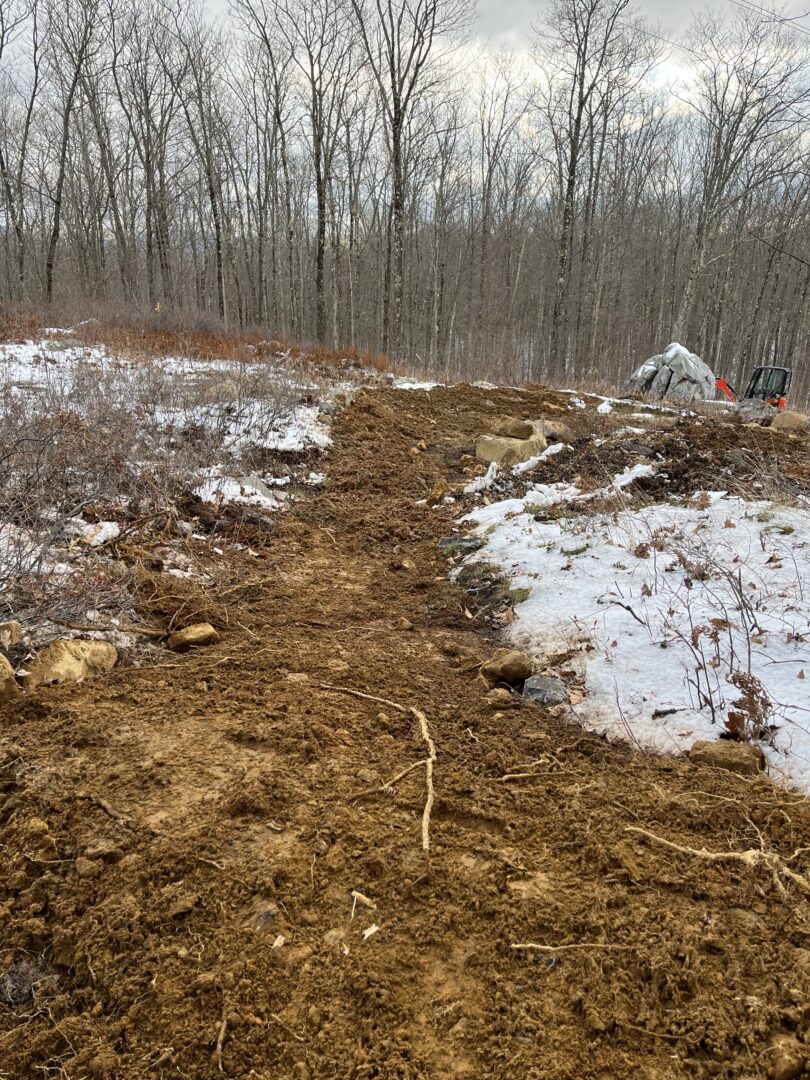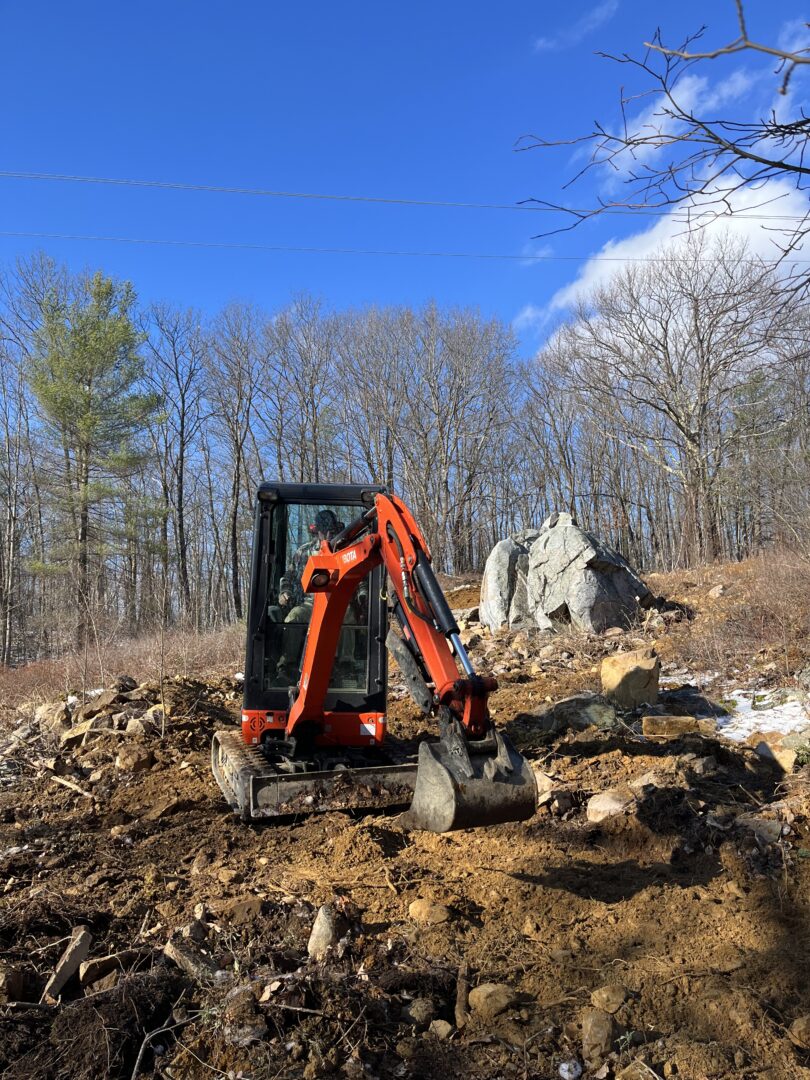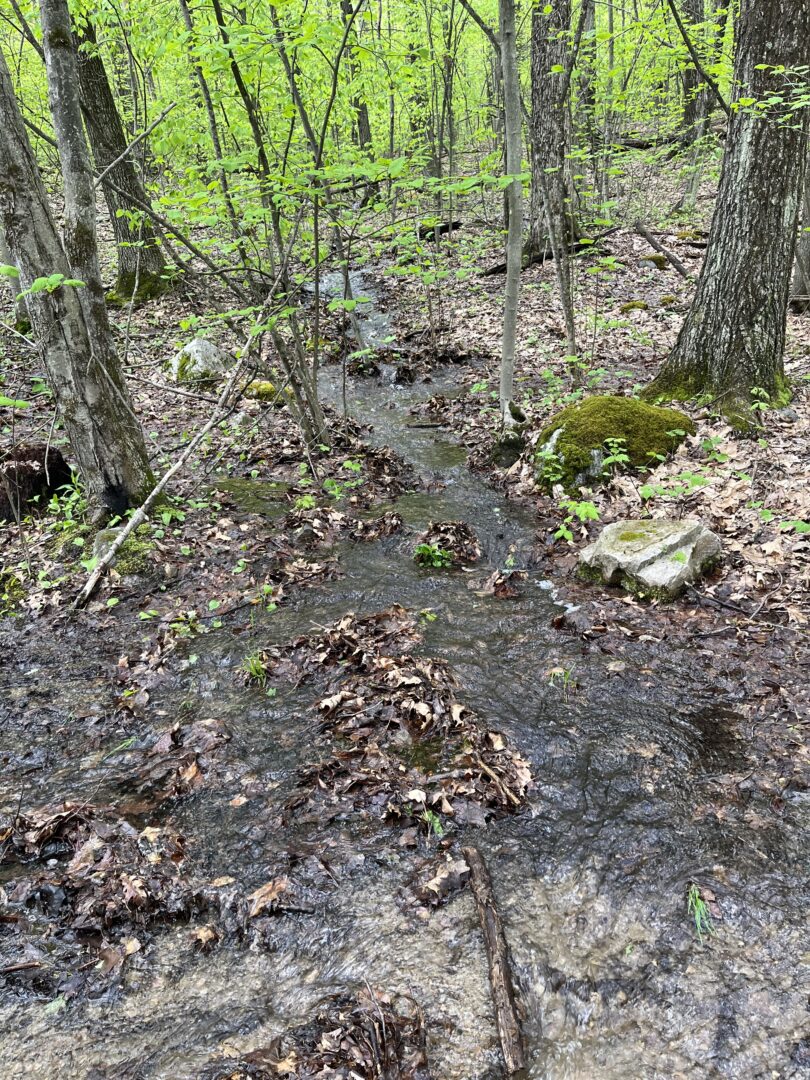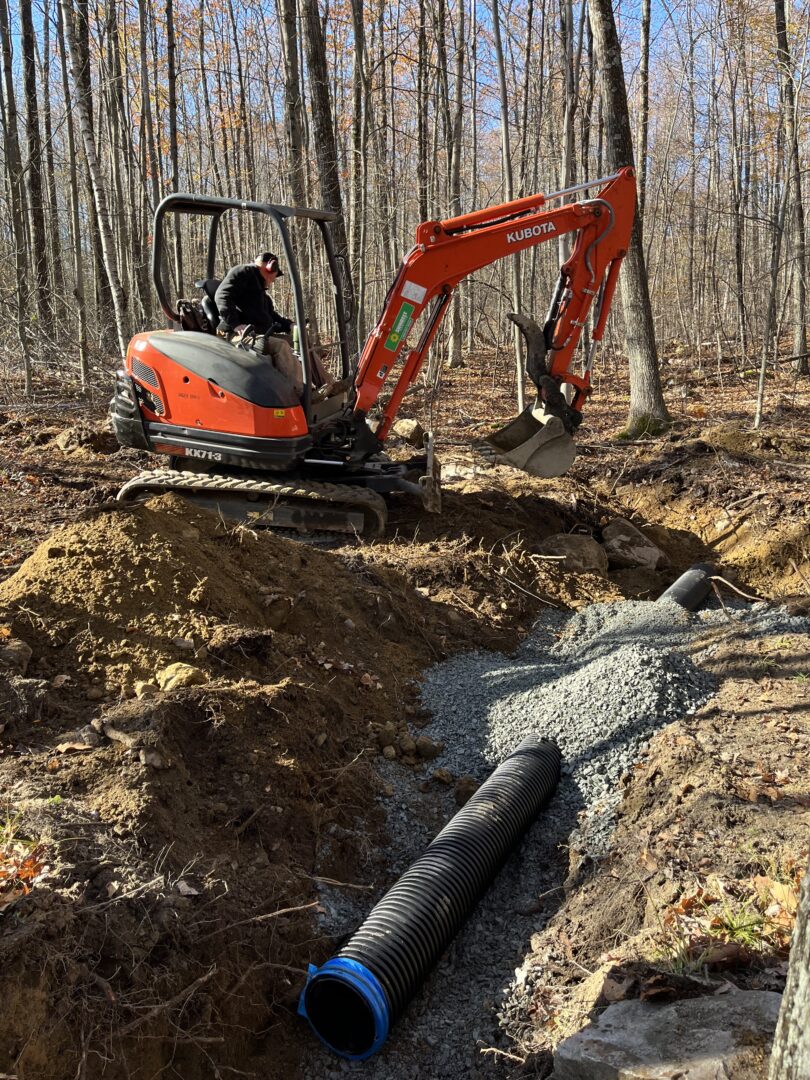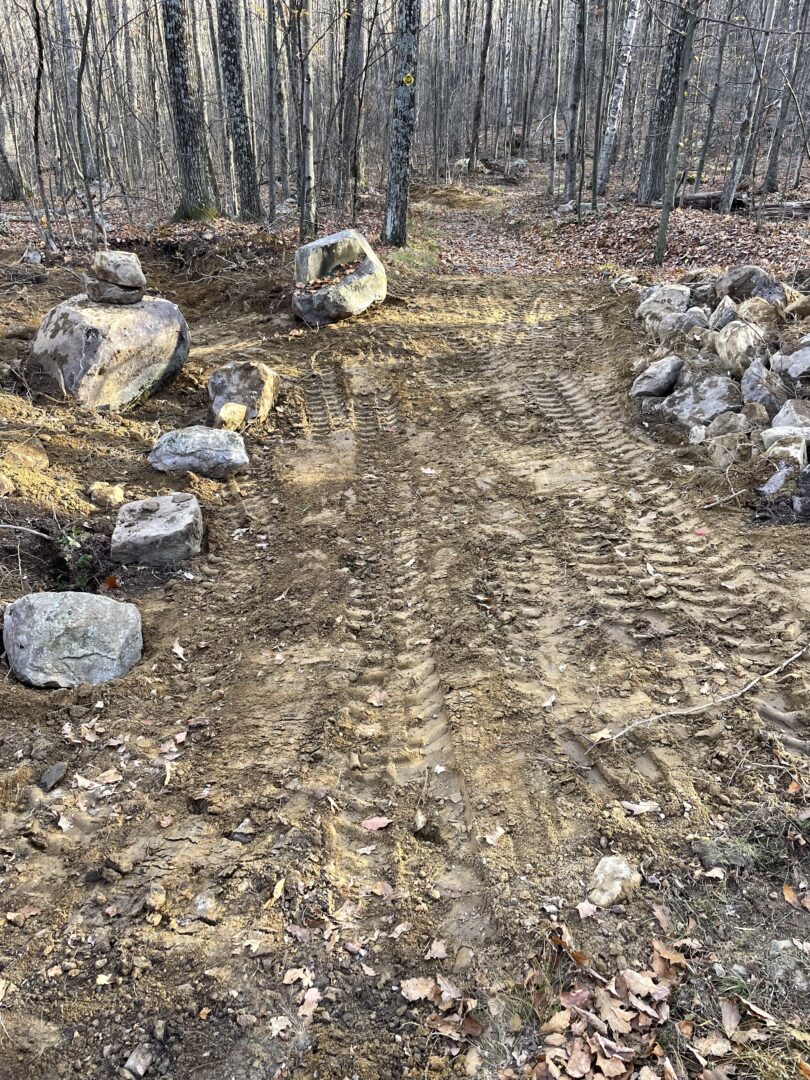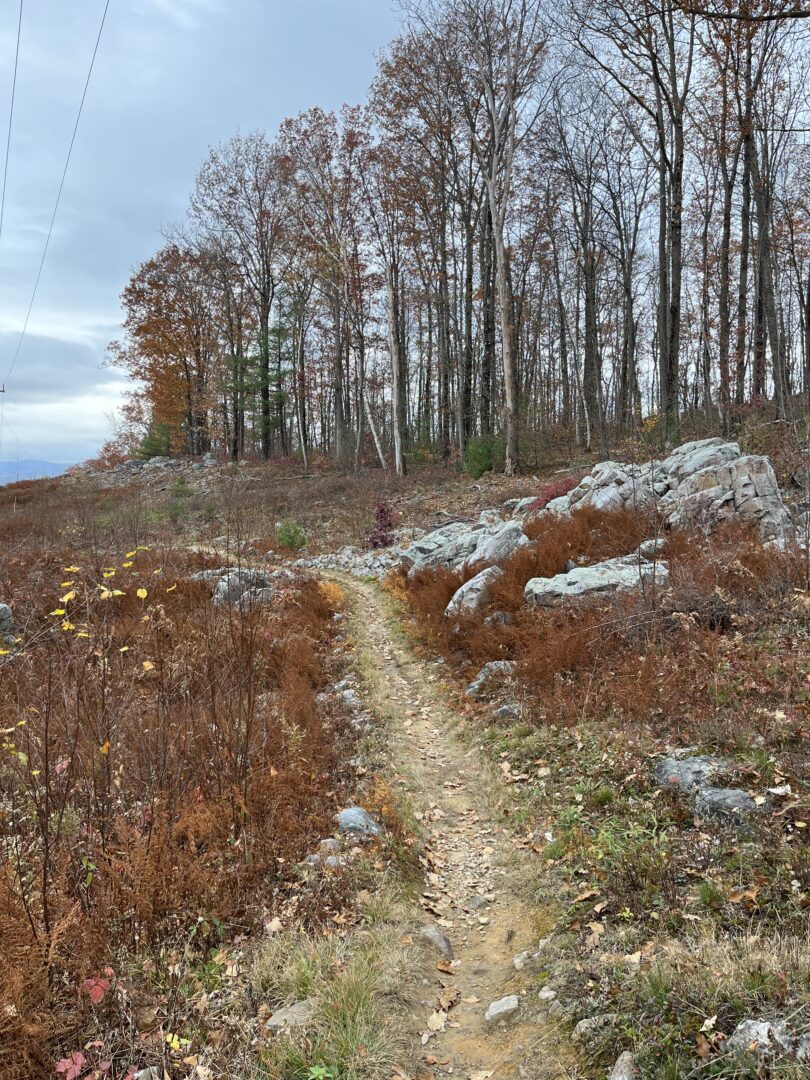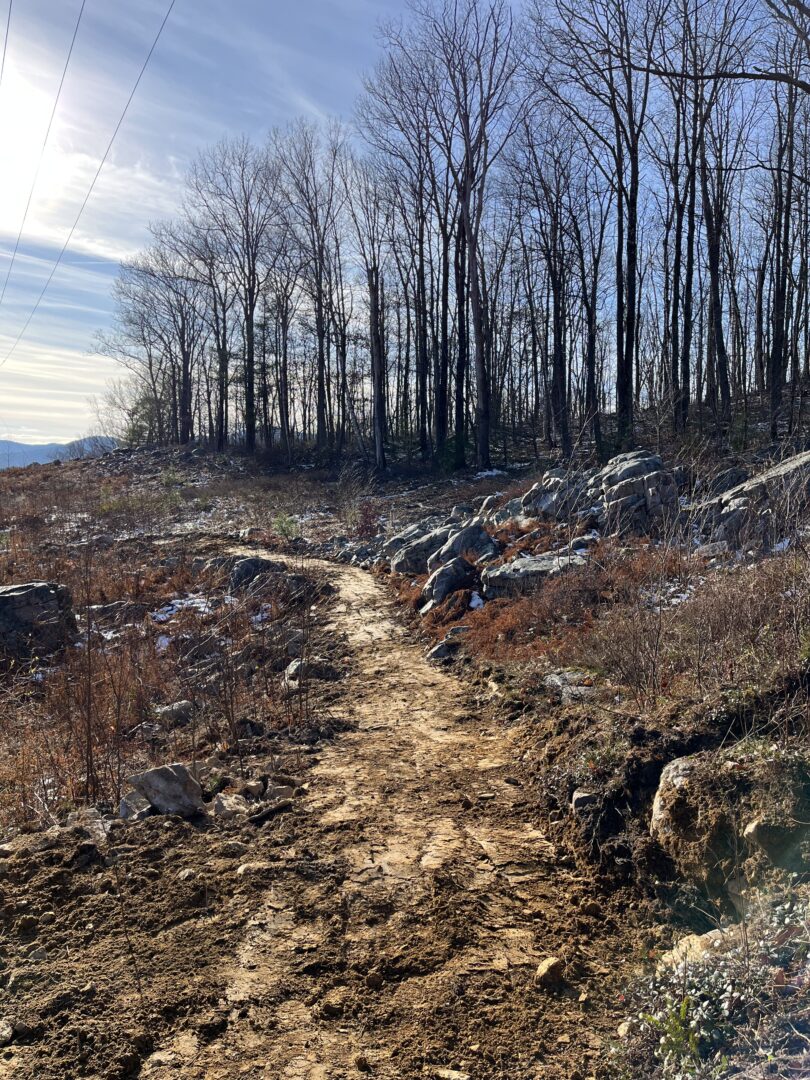Volunteers along with KSA Built have put in two new features on Furlough.
Name this feature by sending pinehillpartnership@gmail.com an email with ‘name that feature’ in the subject line.
Winner gets a choice of Pine Hill Partnership t-shirt or hat.
Volunteers along with KSA Built have put in two new features on Furlough.
Name this feature by sending pinehillpartnership@gmail.com an email with ‘name that feature’ in the subject line.
Winner gets a choice of Pine Hill Partnership t-shirt or hat.
by Tom Estill
Near the first day of spring, 2024, a major snow storm came through the area and dumped about 18” of snow on the ground. On a late afternoon walk the forest was relatively quiet with just a few birds seen including, yellow-crowned kinglet, tufted titmouse, crow, black-capped
chickadee, white-breasted nuthatch, and a turkey vulture flying overhead. On March 26th, snow continued to melt, but it was still very deep. I was hoping to see some of the first migrants to arrive, but saw only tufted titmouse, pileated and downy woodpeckers, crown, white-breasted nuthatch and a red squirrel near the trailhead.
On a March 28th hike, snow was melting rapidly, with bare ground becoming a more and more common sight. A good day for birdwatching with a cardinal, mourning dove, Carolina wren, dark-eyed junco, tufted titmouse, black-capped chickadee, American goldfinch feeding on birch catkins, crow, golden-crowned kinglet, white-breasted nuthatch, ruffed grouse, and pileated woodpecker, all being seen.
On March 30, the first wildflower of the season was seen flowering where it’s always seen-in the wetland areas adjacent to the boardwalk near the trailhead. That flower is, of course, COLTSFOOT. Also, on this day was seen the first migrating warbler, the black and white warbler. Dark-eyed juncos were chasing one another, establishing their territories, and a few Canada geese were sitting on their nests on the little islands on the west side of Muddy Pond.
Also, on the pond were a few pairs of mallards, and about a dozen common mergansers. It felt like an early spring day.
On the last day of March, a Cooper’s hawk was seen bringing nesting material to a nest it was building near the Lower Giorgetti trail, close to where last year’s Cooper’s Hawk nest was located, but which has since been abandoned. A second Cooper’s Hawk was seen perching near the nest they were building.
By the first day of April, Eastern chipmunks were out and about in large numbers, a red squirrel had set up a nest near the trailhead, the first butterfly of the season was seen, the Mourning Cloak(always the first!), and always seen in the few open areas in the park where the American chestnut trees were planted in the past, flying insects were becoming more numerous, many painted turtles were sunning themselves at both Muddy and Rocky Pond, and one Osprey was seen on its nest at Muddy Pond.
The second week of April found mostly sunny days with temperatures in the mid-60s. An Eastern phoebe was seen flying in and out of one of the abandoned quarry buildings on Crusher Rd. I could see its nest high up on an overhang near the ceiling. The same place it’s been making its nest for years. Numerous bluebirds also seen near the quarry. Hundreds of wood frogs croaking in the wetland area at the south end of Rocky Pond.
By the second week of April, trailing arbutus was flowering (always second after Coltsfoot), the Hermit Thrush had returned and Trout Lily leaves were beginning to emerge from the forest floor. On the 14th, yellow-bellied sapsucker was back and drumming, while on Muddy Pond, 2 Osprey were seen on and near their pole extension nest.
A day later a doe, and 2 yearlings accompanying her, were seen on Droopy Muffin trail. They would be seen numerous times in the following weeks. Two adult Canada Geese had set up nests on the west side islands on Muddy Pond. They obviously were sitting on eggs, because every time I checked the nests, they’d be sitting there, while their mate was nearby keeping strangers away.
On April 16th, I was surprised at how quiet the forest had become and I saw but a few birds including cardinal, tufted titmouse, white-breasted nuthatch, and Bluebirds flying in and out of the next they had recently occupied at the top of a dead white birch adjacent to quarry buildings.
During the third week of April, wood anemones were flowering, one of the Cooper’s Hawk was continually sitting low on its nest, very likely keeping its eggs warm, a brown creeper was seen bringing nesting material to its recently constructed nest, a solitary vireo was seen, and the bluebirds were seen flying continually in and out of their birch tree nest.
By the last week of April, trout lily were in flower, black-capped chickadees could be seen feeding on red pine seeds, belted kingfishers had returned to the ponds, bumblebees were out in large numbers, bellwort and sedges were in flower along with various violets, many bullfrogs and green frogs were calling at the ponds, and fiddleheads were opening,
During the first week of May, Dave Jenne, Shelley Lutz and myself went on a 5 hr. birdwalk and saw black-capped chickadees, crow, American goldfinch, tufted titmouse, downy woodpecker, cardinal, Carolina wren, white-breasted nuthatch, robin, brown creeper, American redstart, ovenbird, blue headed vireo, least flycatcher, northern flicker, Eastern phoebe, great crested flycatcher, field sparrow, hermit thrush, Eastern bluebird, hairy woodpecker, yellow-bellied woodpecker, black-throated green warbler, Eastern towhee, blue jay, black-throated blue warbler, red crossbill, black and white warbler, catbird, and white-throated sparrow. At Muddy Pond could be found many painted turtles sunning themselves, Canada geese nesting, and Common Mergansers. Catkins were hanging from the limbs of white birch trees.
During the second week of May, Moccasin flowers, Gay wings, star flowers, foam flower, butter and eggs, wood betony and pale corydalis were all blooming. Numerous reports of a sow and accompanying young bear seen at south side of park, adjacent to residential area. Female Cooper’s Hawk appears to be feeding young. Scarlet tanagers had returned, and after a rain, numerous red efts could be seen on the trails. Had to be careful where I put my foot. By this time of year, emerging tree leaves are making it harder to see birds higher up. Indigo buntings were back in numbers I have never seen before, red-wing blackbirds were nesting at Rocky Pond, ruby-throated hummingbirds were seen for the first time this season, and
Jack-In-The-Pulpit was blooming.
During the third week of May, I saw my first yellow warbler this season, while chestnut-sided warblers, red-eyed vireos, American redstart, black-and-white warbler, tufted titmouse, Eastern wood pewee, indigo buntings, northern cardinals, Carolina wren, veery, common yellowthroat, black-capped chickadee, least flycatcher, osprey and Canada geese were regularly heard or seen on just about every walk I went on in the park.
The last week of May I saw my first northern parula and cedar waxwing of the season.
Forget-me-not, Common buttercups, red clover, blackberries, fleabane, blue-eyed grass, and hawkweed were all blooming, and evergreen pollen was covering the perimeter of both Rocky and Muddy Ponds. The red admiral butterfly was seen under the power lines on the Carriage Trail, a place where I see them every year.
During early June, Field Cow Wheat, Tufted loosestrife, and Blue Flag were all flowering. And on June 7th, I replaced two dead American Chestnut trees with American Chestnut seedlings, and saw a beautiful Hummingbird Clearwing Moth. In Mid-June, the inevitable finally happened after 12 years of walking all around Pine Hill Park, observing the wildlife and planting trees and wildflowers-I was diagnosed with Lyme Disease. And it knocked me flat for at least two weeks. So, I’m ending my report here.
Hope you enjoyed this summary. Please remember to stay on the trails, and enjoy watching the Wildlife of Pine Hill Park.
Updated: April 1, 2024:
Trails are open. Please be smart when you ride. We have more significant snow in the forecast for mid-week.
Don’t be this entitled mountain biker. This occurred after the 2 foot snowstorm on Saturday, March 23rd and March 30th. The rut in top picture had already been repaired.
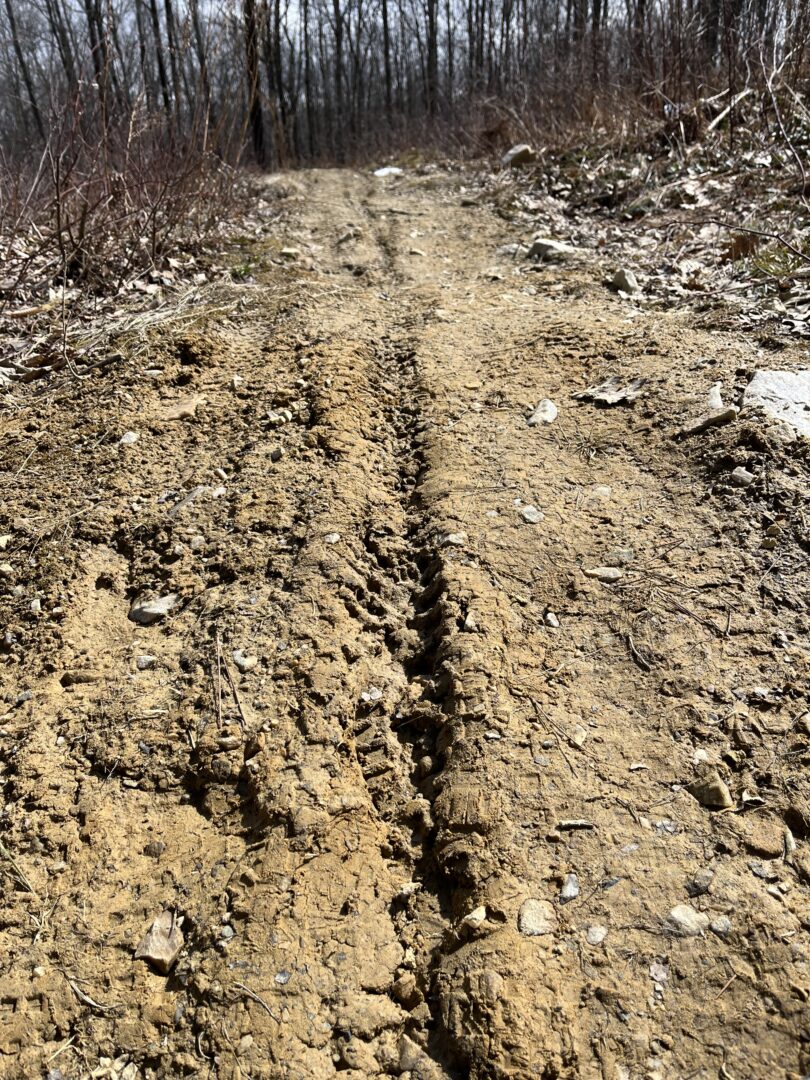
We have closed Exit Strategy, Droopy Muffin steep hill-between Intersection 30 and 30A and Lichen Rock. We have problems with freeze thaw cycles on these particular trails throughout the winter into early spring. Please respect closed trails. Thank you your hard working volunteers.
Tom had another great adventure in the park this spring:
The first day of spring found Rocky and Muddy ponds both still covered in ice. A crow, Northern Cardinal and Tufted Titmouse were the only birds seen on my walk that day. But I had the most fun setting up my trail cam in a rocky cliff face along the Carriage trail in an attempt to capture video of what I believed was a porcupine denning in the rocks. Porcupine tracks leading to the area, porcupine scat, and distinctive porcupine chew marks on nearby trees all led me to believe a porcupine was denning in the area.
A few days later on March 23rd, I went on an evening walk and, while standing along the shore of Rocky Pond, observed a dozen turkey vultures soaring high above the Ledges there, and then start to slowly descend one by one onto and amongst the rocks. This is something I have observed many times over the years, always around the Spring Equinox. It makes me wonder if that area was closed to the public(something I am NOT proposing) would turkey vultures nest there? This day was also the first time I observed robins in the park. And, of course, gray squirrels were busy scurrying around.
The next day, I noticed that most snow was now gone from the lower trails, but increases as you go up in elevation. Bird courtship behavior was becoming more evident, with two hairy woodpeckers observed fighting each other over a nearby female hairy woodpecker. It was the first day I felt that spring had finally arrived. Red-bellied woodpecker, hairy woodpecker, downy woodpecker, robin, tufted titmouse, black-capped chickadee, and white-breasted nuthatch were all observed. Both ponds were still completely frozen over with the exception of a small band of open water along Rocky Pond, and near the beaver dam on Muddy Pond. Eastern newts were seen in the open waters. Two pairs of Canada geese were seen in the open waters of Muddy Pond.
By March 26th, recent mild temperatures helped to melt snow, and there was much water flowing into Rocky Pond from the stream flowing under the walk bridge. The following morning walk was absolutely beautiful with my first seasonal sighting of chipmunks and Eastern bluebirds checking out the bird houses near the trail head. Song sparrows near the trailhead, red-shouldered hawks and broadwing hawks flying overhead, mallards and Canada geese at Muddy Pond, and a small pearl crescent butterfly flying about, all suggested that the great northern migration was underway.
On April 1st, I observed my first wild flower in the park, the Coltsfoot flower. Always the first flower to appear. Also observed my first mourning cloak butterfly, one of the first butterflies to appear in the park each early spring. Wood ducks, mallards, and Canada geese were seed at Rocky Pond and the Rocky Pond outlet area, a place I am sure wood ducks nest each year, though I’ve never seen an active nest there.
On April 3rd, Rocky Pond was finally ice free, and the forest was very quiet with only hairy woodpeckers and tufted titmouse being observed.
April 4th found nesting Canada geese, a dozen common mergansers, and a sleeping beaver all at Muddy Pond. A beautiful deer was seen near the 16A trail sign, and my trail cam showed a porcupine at that site on the Carriage Trail I had mentioned earlier.
A few days later, Eastern phoebes and a golden-crowned kinglet were seen for the first time in the park, and a pair of Osprey were seen at their nest platform at Muddy Pond. Eastern newts were mating at Rocky Pond.
As the days went by, more and more signs of spring were seen. Yellow-bellied sapsuckers had returned, a Cooper’s hawk was nesting in a tree along the 2nd Giorgetti trail, painted turtles were basking in the sun at Muddy Pond, and wood frogs were calling in the wetland area on the south side of Rocky Pond..
During the second week of April, trout lily started to appear on the forest floor, trailing arbutus and oak trees were now flowering, spring peepers and leopard frogs were calling, and hermit thrush were singing. Ring-necked ducks were seen at Muddy Pond. On April 15th I had the wits scared out of me when a ruffed grouse suddenly exploded into flight from a spot very close to where I was walking. So perfectly camouflaged are those birds.
During the third week of April, wood anemone, sedges, and barren strawberry were in flower.
A week later, I planted an American Chestnut tree seedling near Rocky Pond. The seedling came from a seed harvested by Mount St. Joseph Academy advanced biology students in the fall of 2022, and refrigerated until March of 2023. The students have been taking care of an orchard of 20 American chestnut trees since 2019 in the back of their school. In 2022, they harvested their first 27 viable American chestnut seeds, a first for a Vermont school.
During the first week of May you could find two-leaved toothwort, white violets, gay wings, bellwort, and wild strawberries all flowering. New birds seen included ovenbird and
yellow-throated vireo.
In Mid-May red eyed-vireos, house wrens, great blue heron, great crested flycatcher, and veery could be seen and heard, and flowers blooming included Solomon’s seal, false Solomon’s seal, wood betony, foam flower, and starflower.
During the last week of May I saw the beautiful northern oriole at Rocky Pond, the stunning indigo bunting at its usual nesting place underneath the power lines on Carriage Road near Rocky pond, and the breathtaking scarlet tanager in numerous places in the park.
Chestnut-sided warblers and American redstarts were back in good numbers. New flowers in bloom included common buttercup, early azalea, garlic mustard, and common cinquefoil.
During the first week of June I planted a new American chestnut seedling up at Rocky Pond to replace one that died over winter, and saw my first Viceroy and Eastern Swallowtail butterflies. The Viceroy is easily confused with the Monarch butterfly, but is smaller and has a black line across the lower part of its main wings.
During the second week of June you would likely see the following birds in the park: Song sparrow, Canada geese, great blue herons, wood ducks, common mergansers, tufted titmouse, American redstart, chestnut-sided warbler, red-eyed vireo, yellow-throated vireo, scarlet tanager, indigo bunting, Eastern towhee, ruby-throated hummingbird, catbird, yellow-bellied sapsucker, Eastern pewee, barred owls, hermit thrush, veery, and ovenbird. New flowers in bloom would include: common fleabane, ox-eye daisy, ragwort, sarsaparilla and moccasin flower.
On June 19th, I discovered a great blue heron nesting in the wetland area just behind the major inlet to Muddy Pond at the west end of the pond. I also saw my first White Admiral butterfly of the season..
That’s it for this issue. Please stay on the trails and enjoy observing the wildlife at Pine Hill Park.
Saturday, April 29th, 9AM meet at the front entrance. We will be working on Bone Spur doing finish work up near Milk Run/Watkins Wood Rd. This will be tilling and raking for our finished trail tread. And of course, new bark mulch for the front entrance gardens to make them look pretty!!! Hope to see you there!
Save the Date: A community B-B-Q is happening on Saturday, May 20th. We will have some guided rides and hikes starting at 10AM with food at 12:30pm. Everyone is welcome to come. Do your own ride or hike, then join us for food.
April 15, 2023
Great news! All of our trails are open to bikes, pedestrians, runners. We are completely amazed at how dry the park is for this time of year.
Trail maintenance will continue through the spring and summer.
Just a quick reminder that these trails are built and maintained by volunteers. Please consider joining Pine Hill Partnership by using the button on the front page—or by leaving a donation in Tinman when you visit us.
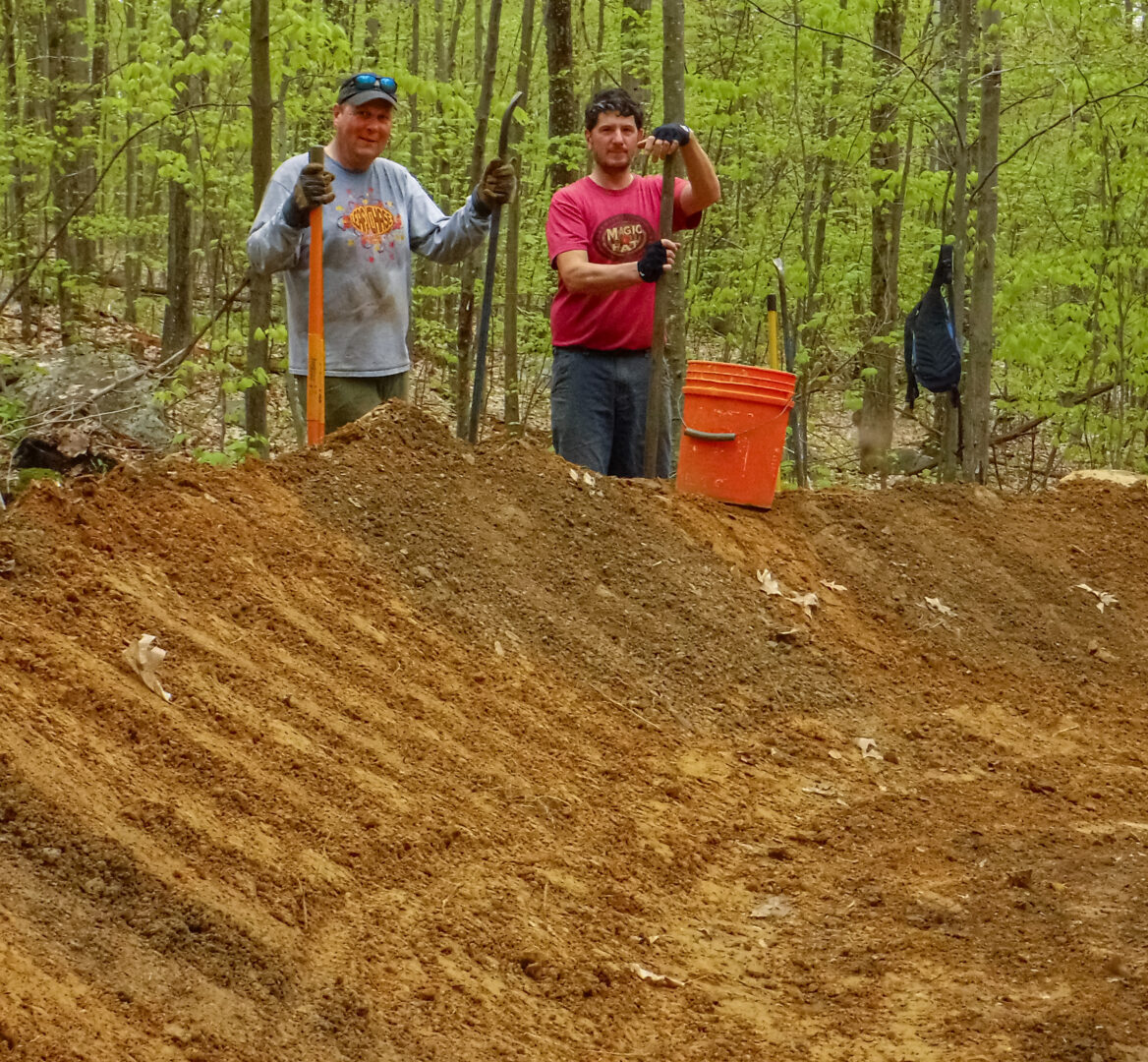
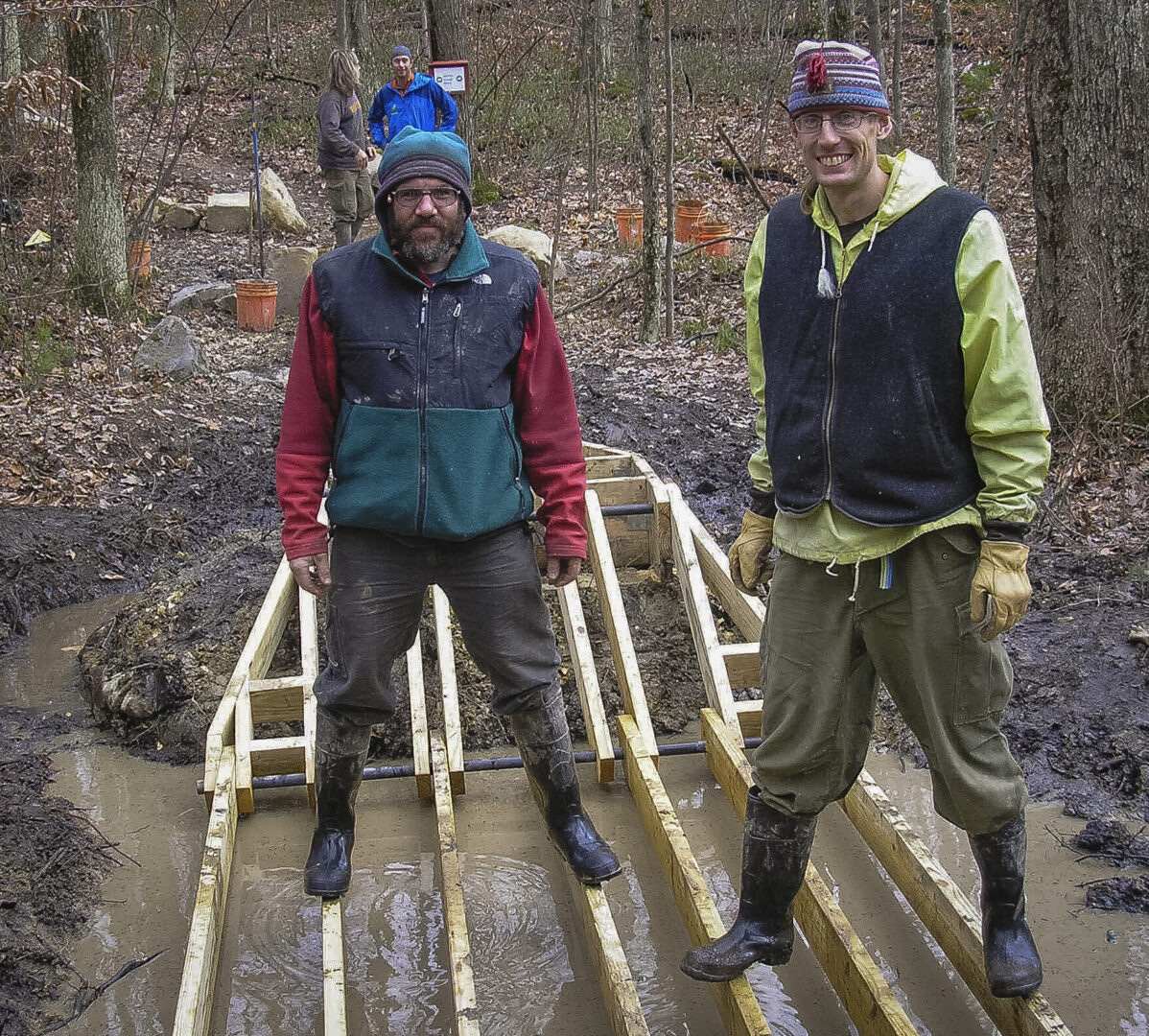
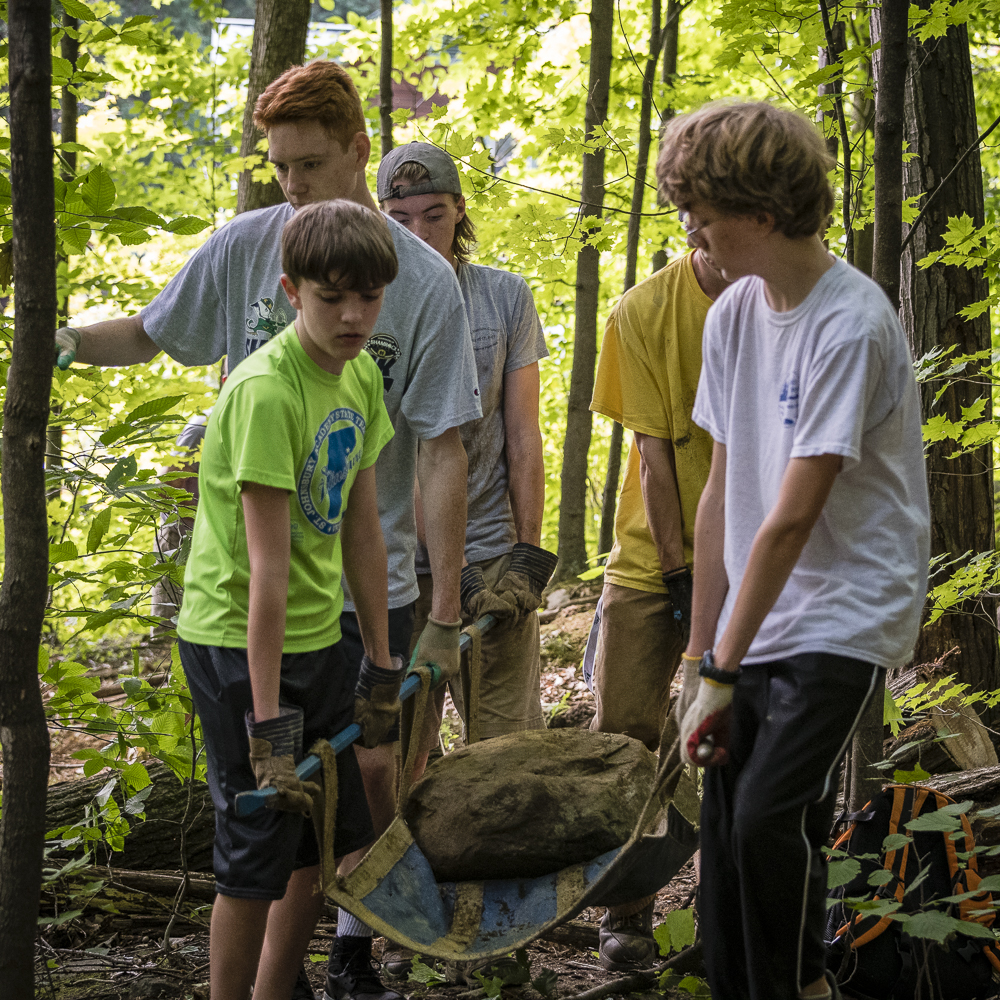
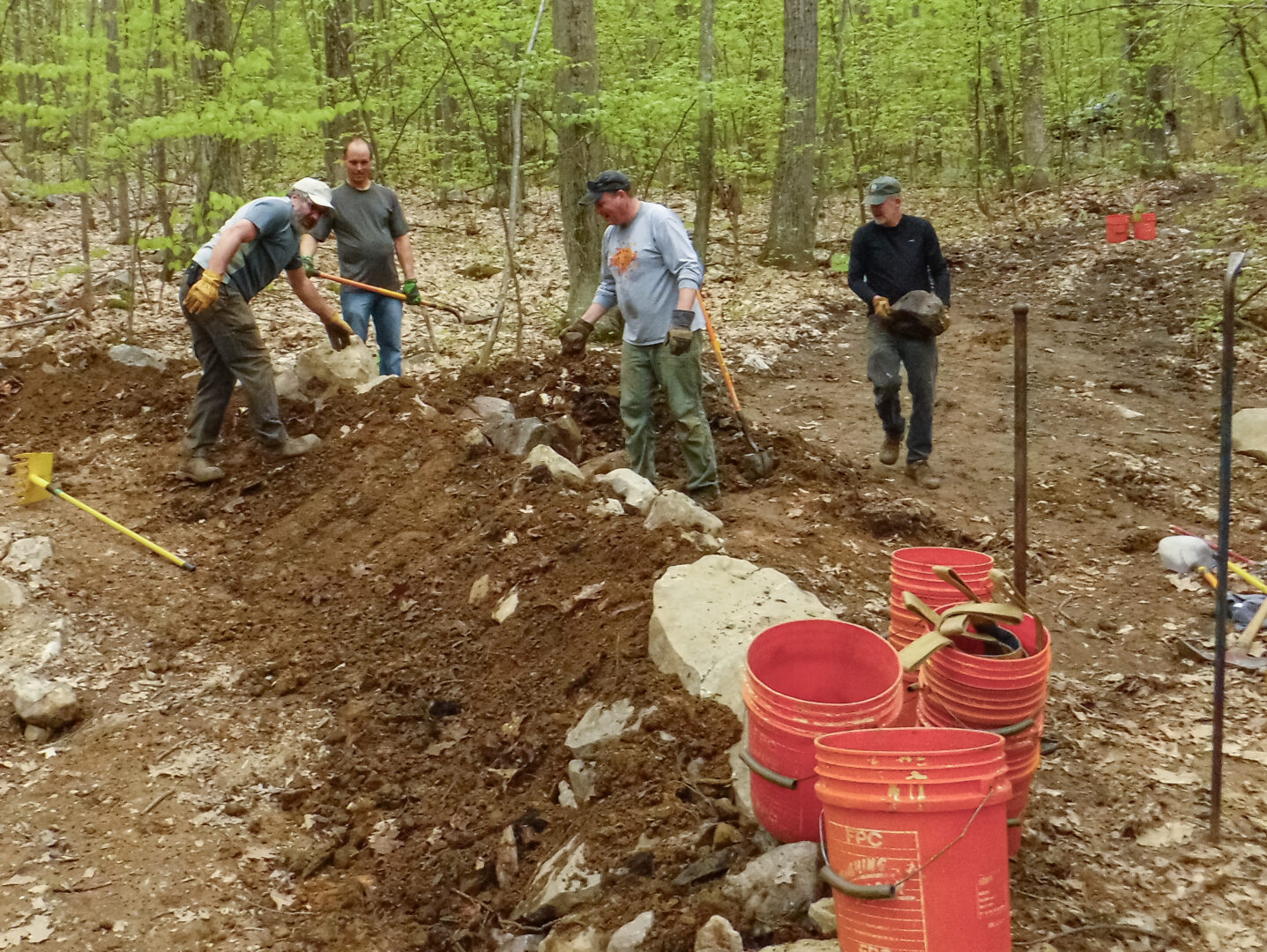
We’re the first trail network to open in the state, so please be considerate of our volunteers who have worked super hard to create a great trail system. Unfortunately, trails do not magically appear :- )
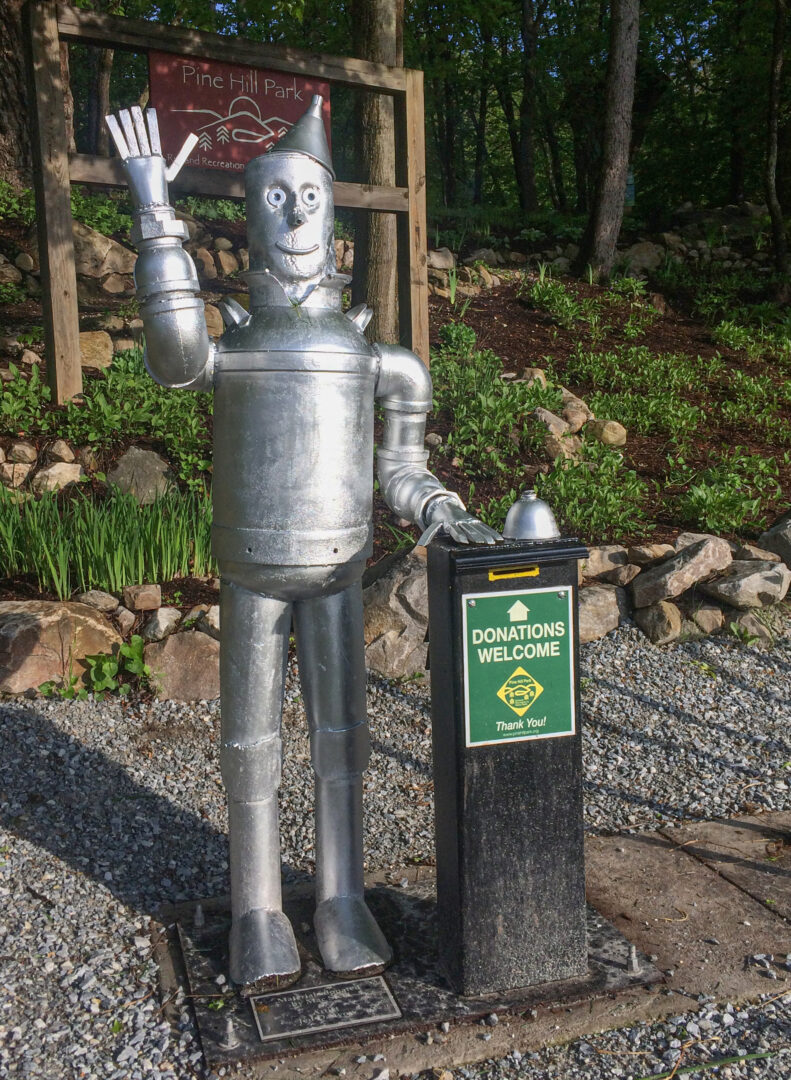
Thank You !
By Tom Estill
Wild Times at Pine Hill Park Winter 2022-23 Summary
The beginning of winter found both Rocky and Muddy Ponds frozen over, and the forest birds were being regularly seen together in their loose association of black-capped chickadees, crows, tufted titmouse, white-breasted nuthatch, and downy woodpeckers.
During the last week of December, I was pleasantly surprised to see a Cooper’s hawk flying near the trailhead, and a small flock of southerly migrating Canada geese. Chipmunks were still scurrying about, busy collecting and storing acorns and other food items in preparation for the cold weather ahead. A few inches of snow covered the ground, while ice covered many of the trails.
The last day of December found temperatures in the high 40s(F), and low 50s(F). Deer were seen crossing the Carriage Trail, and a barred owl was seen under the powerlines on the Carriage Trail on the way to Rocky Pond.
Jan. 1st weekend was the Christmas Bird Count for Pine Hill Park. Participants included myself, Shelley Lutz, and Dave Jenne. Birds seen and their numbers included: Crow(15), Black-capped chickadee(23), downy woodpecker(8), white-breasted nuthatch(17), tufted titmouse(20), mourning dove(7), cardinal(6), house sparrow(4), dark-eyed junco(3), Eastern bluebird(2), blue jay(1), red-bellied woodpecker(3), house finch(1) and brown creeper(4).
Jan. 2nd found me exploring rock outcrops near Rocky Pond and finding porcupine and deer tracks, with porcupine tracks and scat leading to an active den among the rocks.
That first week of Jan. also found a few small areas around the perimeter of Rocky Pond with open water and an otter coming in and out of a small hole in the ice at Rocky Pond with a small fish occasionally seen in its mouth. That was exciting enough, but what I saw on the way back to the trailhead had a profound effect on my view of nature. I have seen hundreds of deer at Pine Hill Park over the years, always a pleasure to see. But what I saw on Jan. 8th was different. While walking along the lower ledges trail, near trail marker 24, I was surprised, when not more than 50 ft. from me, three deer seemed to appear out of nowhere right in front of me.
I didn’t see or hear them until they moved, and then they just slowly disappeared into the forest.
I stood there and thought to myself how supremely adapted deer are to their environment. Their camouflage was perfect. Their gray bodies blending in with the large gray boulders, their legs with the tree trunks, and just enough white to help break up the gray. It took thousands of years of evolution for those beautiful animals to reach that point of perfect adaptation to their environment. That encounter changed forever my opinion about deer. Amazing animals
indeed.
By the next day, both ponds were once again completely frozen over. The only birds seen on my walk were white-breasted nuthatch, black-capped chickadees and a hairy woodpecker.
By mid-January most snow was gone on the ground, and on a windy, cold Jan. 6th day, I saw only one bird, a white-breasted nuthatch. Rocky Pond was completely frozen over with long streams of featherly like snow drifting over its surface, which from a distance looked like wind blown waves on the surface of the ocean. It seemed odd to me that a small area of open water would be found near the eastside beaver den on Muddy Pond on such a very cold winter day.
The last week of Jan. found the forest floor once again covered in snow, both ponds frozen over, and numerous deer tracks found throughout the whole forest.
By the first week of Feb., the silence of winter had set it upon Pine Hill Park. Very few birds seen, bitterly cold days, and ponds frozen solid. One Feb. 2nd, I had a close encounter with a pair of black-capped chickadees who flew within just a few feet of me. They seemed very inquisitive and almost tame.
On Feb. 6th, I saw a Cooper’s hawk along the lower Giorgetti and a barred owl near trail marker
16. Also was lucky to find an abandoned broad-winged hawk nest, high in the white pine tree directly behind the Station #5 Sign on the Lower Giorgetti Trail. For years, I’ve observed a broad-winged hawk in that area and just knew it had a nest somewhere nearby.
On Feb. 13th, I had that feeling that the worst of winter was behind us and that signs of spring would soon start to appear. I started looking for snow fleas(springtails), a sure sign for me that we were over the “hump” of winter. Though Rocky Pond was completely frozen over, Muddy Pond had a few small areas of open water on the East side(it receives the most sun) near the large beaver den. A large deer was seen near trail marker #24, and birds seen included hairy woodpecker, tufted titmouse, black-capped chickadee, and white-breasted nuthatch.
Two days later, with recent warm temperatures, the lower trails were mostly devoid of snow and ice, while upper trails still were covered with snow. Rocky Pond had large areas of standing water, especially along the shores, covering ice beneath.
The first week of March I observed my first snow fleas. I set up a trail camera near Trail Marker 16 and when I checked it the next day, I got a picture of a fox, and an inquisitive deer with its nose up close to my camera lens.
The next day, I set up my camera near Trail Marker L, and saw that I got a picture of another deer. On the way back to the trailhead I saw my first turkey vulture of the season soaring overhead.
On Feb. 9th, snow was melting, some oak trees were showing buds, and 2 large areas of open water were observed on Muddy Pond. Birds seen included black-capped chickadees, tufted titmouse, white-breasted nuthatch, crows overhead, downy woodpecker and red-bellied woodpecker. The next day, snow continued to melt due to relatively warm temperatures.
On March 13th, the ground was once again covered in snow due to recent big storms, and temperatures were noticeably colder. By March 18th, snow was about 6” deep. Lots of deer tracks were observed, Canada geese seen flying north overhead, and cardinals and mourning doves were singing(well, cardinals were singing, doves were “cooing”).
That’s it for this issue. Please stay on the trails, and enjoy your Wild Times at Pine Hill Park.
Tom Estill’s Wild Times at Pine Hill Park is hot off the press! You never know what Tom will find in the woods.
Sorry to say, unlike other years, no burs were produced by the Svelte Tiger America Chestnut tree this year due to the Spongy Moth infestation. During my park walk on the last day of Sept., I saw my first loose association of white-breasted nuthatch, hairy woodpecker, tufted titmouse and black-capped chickadee. Migrating yellow-rumped warblers, blue jay, northern flicker and a red-bellied woodpecker were also seen. Very surprised to see a Mourning Cloak butterfly flying about. Those butterflies will spend the winter under loose bark or other places providing protection from predators and the elements, then emerge in early spring as one of the earliest animals to do so.

Oct. 8th found the forest to be very quiet. The forest was at, or very near, to the height of the fall foliage season. At Muddy Pond could be found hundreds of migrating Canada geese along with a hooded merganser. The only birds I saw on my walk to and from Muddy Pond were a hairy woodpecker and migrating pine warbler. The pine warbler seems to be one of the earliest birds to arrive from the south in the spring, and one of the last to leave in the fall. A few plants were still flowering including the blue aster, wild chamomile, and white aster.
In Mid-October I was very lucky to be at the right place at the right time. While sitting at Rocky Pond I saw two merlins chasing one another. I had never seen a merlin at Rocky Pond before. The last time I saw one was over a decade ago, perched on a tree along the shore of the Patuxent River in Maryland. Otherwise the forest was very quiet. Numerous Canada geese were still resting at Muddy Pond, but mallards and green-winged teals were also seen. In the forest could be found a broadwinged hawk, white-breasted nuthatch, a small flock of dark-eyed juncos, red-tailed hawk, hairy woodpecker, and turkey vultures flying overhead.
The first week of November found temperatures in the low 70s, with about 50 Canada geese seen at Muddy Pond, and only a single white-breasted nuthatch.
One Nov. 11th, Muddy Pond was starting to ice over around its perimeter in a few places along the shore. Rocky Pond showed no signs of ice. Birds seen included a pileated woodpecker, white-breasted nuthatch, and crows.
By the first week of December, both ponds were free of any ice, and there was no snow on the ground. Hundreds of Canadian geese and a pair of Common Mergansers were seen at Muddy Pond. Gray squirrels were running about in high numbers. 3 does were seen near Trail Marker #24, and flying about the trees was a loose association of black-capped chickadees, hairy woodpecker, white-breasted nuthatch, tufted titmouse, downy woodpecker, red-bellied woodpecker, crows overhead.
By December 10th, both ponds were showing signs of ice along a few places of their shorelines. Still no snow on the ground. In the trees you could find a red-bellied woodpecker, black-capped chickadees, hairy woodpecker, white-breasted nuthatch and tufted titmouse.
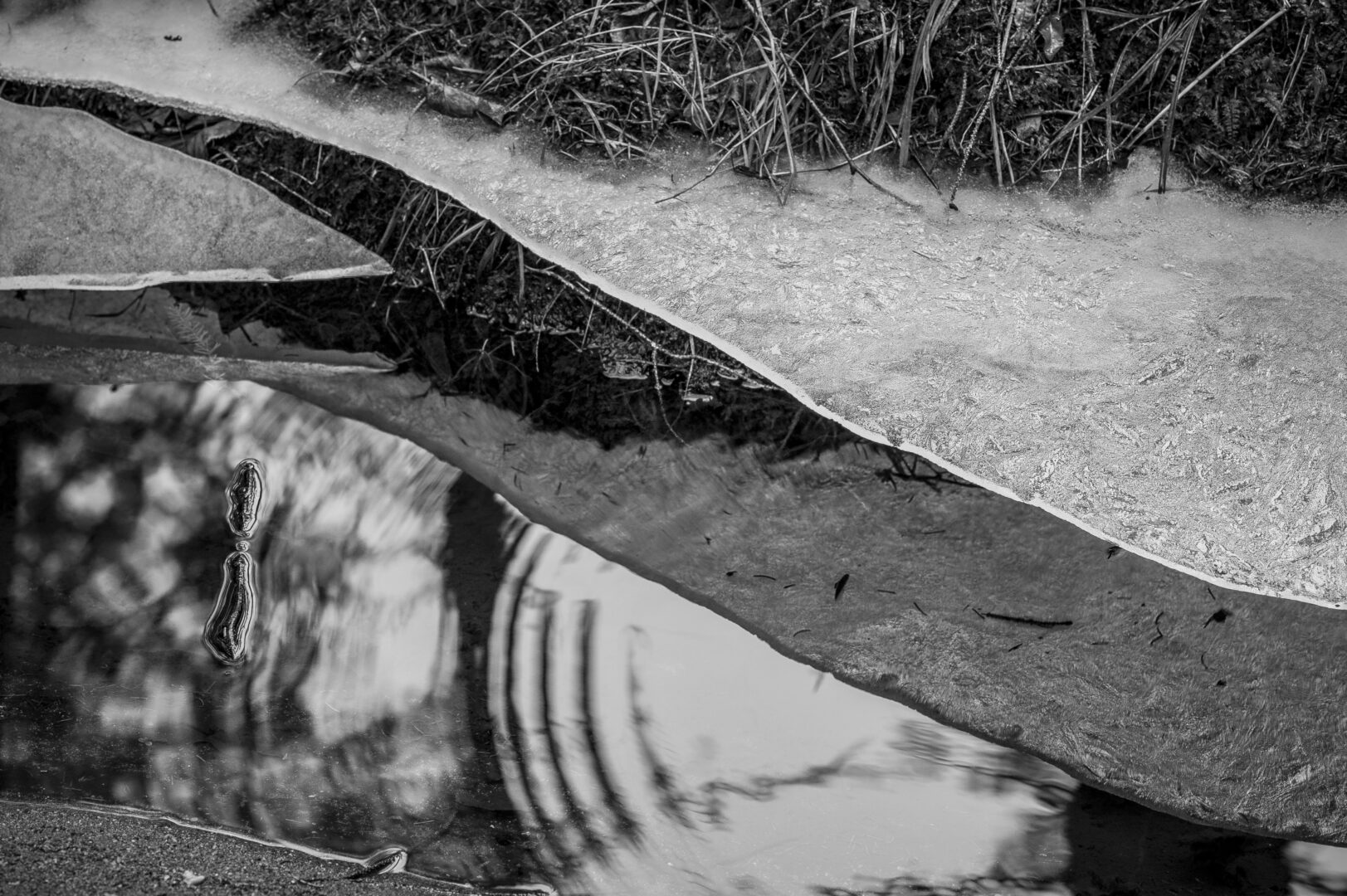
By mid-December, both ponds were finally frozen over. Loose associations of forest birds were now seen almost on a regular basis. The loose association of birds provide extra protection for the birds, and improves their chances of seeing predatory birds nearby.
That’s it for this issue. Please stay on the trails while you enjoy observing the wildlife of Pine Hill Park.
KSA Built is in the park doing trail remediation work thanks to the Enhanced Recreation and Stewardship Grant that Rutland Recreation received.
We are super jazzed about how the trails that cross the upper power line are coming out. Arthur’s Chair(Upper Jersey) has had a tune-up. Strong Angel and Upper Jersey Turnpike have had a lot of work on them are now open. Watkins Wood Rd spring area received a culvert to hopefully eliminate that spring mud hole.
Exit Strategy had to sit over the winter. Rosey had gotten the mini on it only to have it snow the following day. It sat over the winter all roughed in and finish work was done in early April. Exit Strategy opened the earliest that we can remember in quite a few years. The whole park really never closed for spring freeze/thaw cycles.
Underdog, Salamander, upper Droopy Muffin, PA4J and Casey’s Cross all have been repaired. Where these trails cross the power lines and it’s sunny and warm(above 25 degrees) please stay off those sections of trails. The dirt has a lot of moisture in it being recently disturbed and will rut extremely easy. We would appreciate it if folks just be aware of tire and foot traffic leaving ruts in the dirt. We do not need to readdress these in the spring.
Casey’s Cross will get more repair work done as we missed the spring that floods the area.
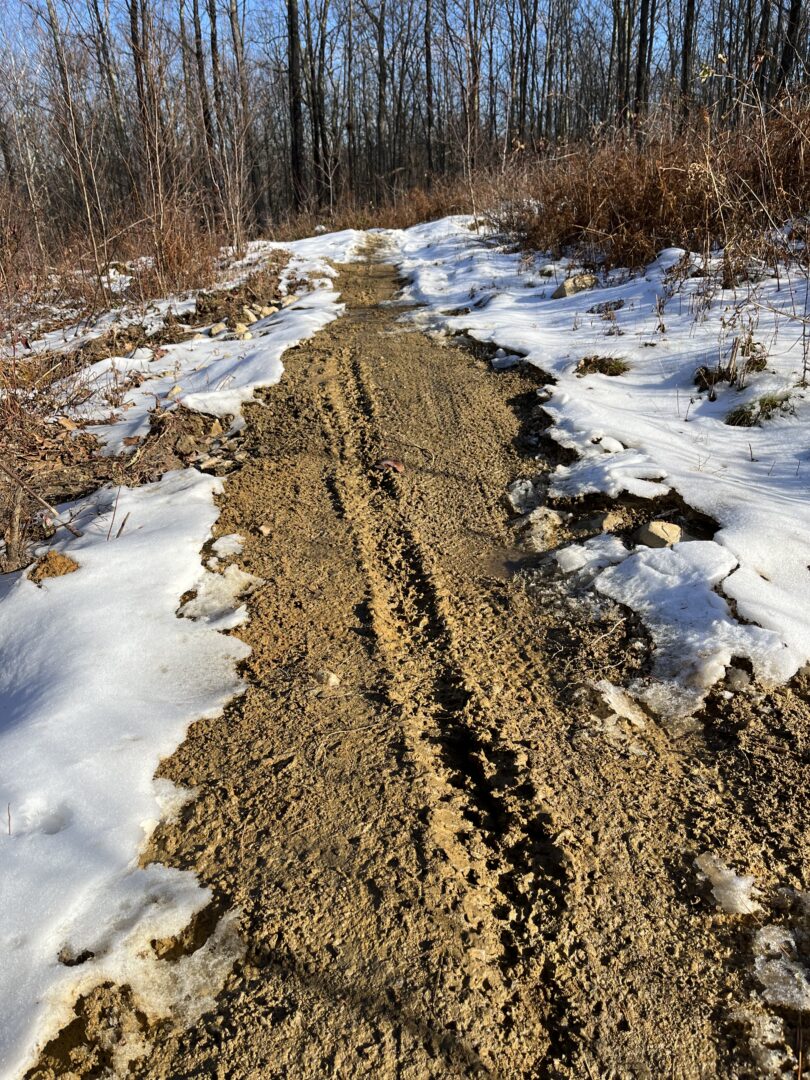
The work KSA Built is doing is fantastic with more refinements starting in June. Broken Handlebar North, all of Halfpipe and Escalator will all get tuned up.
A few before and after pictures.
